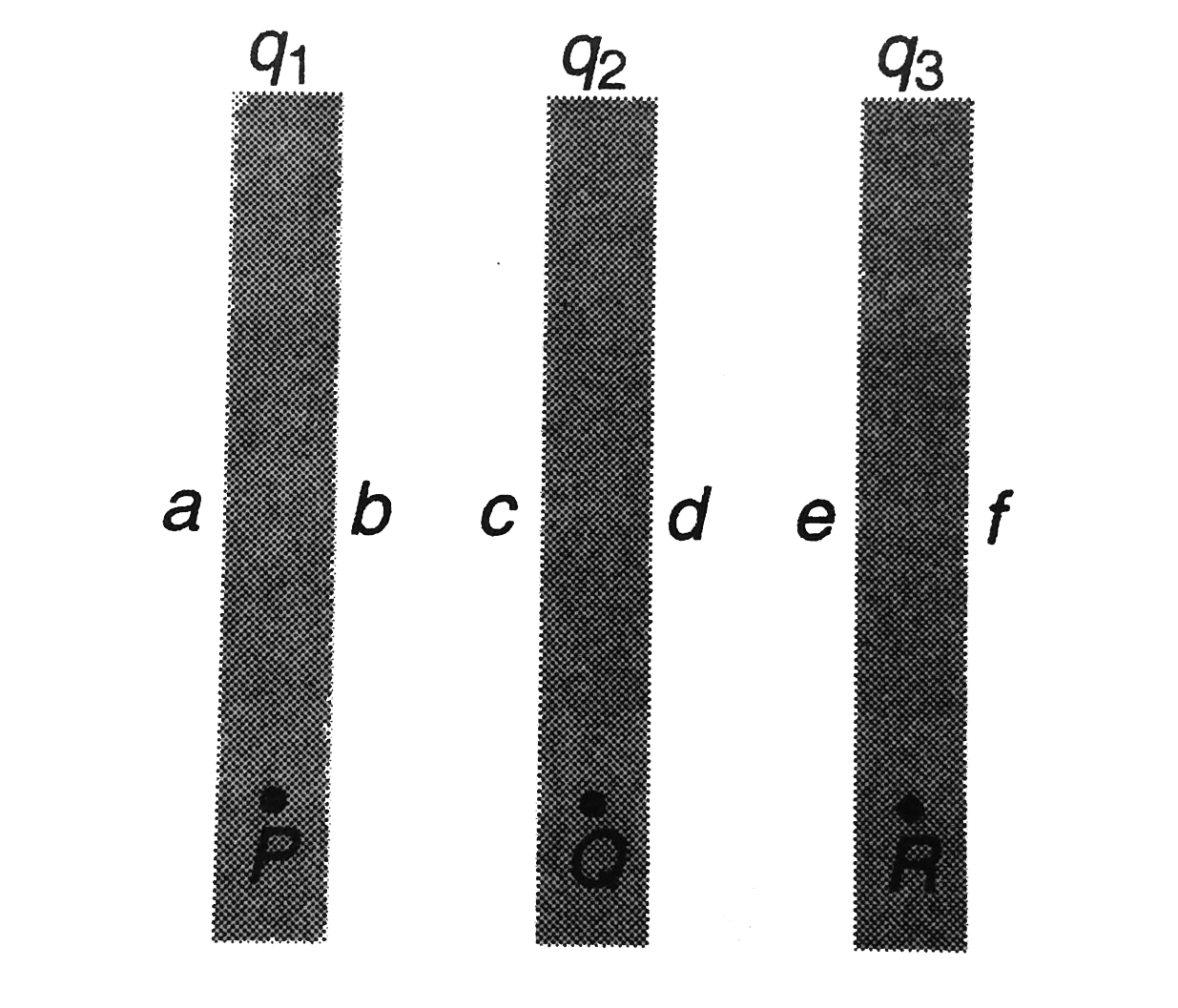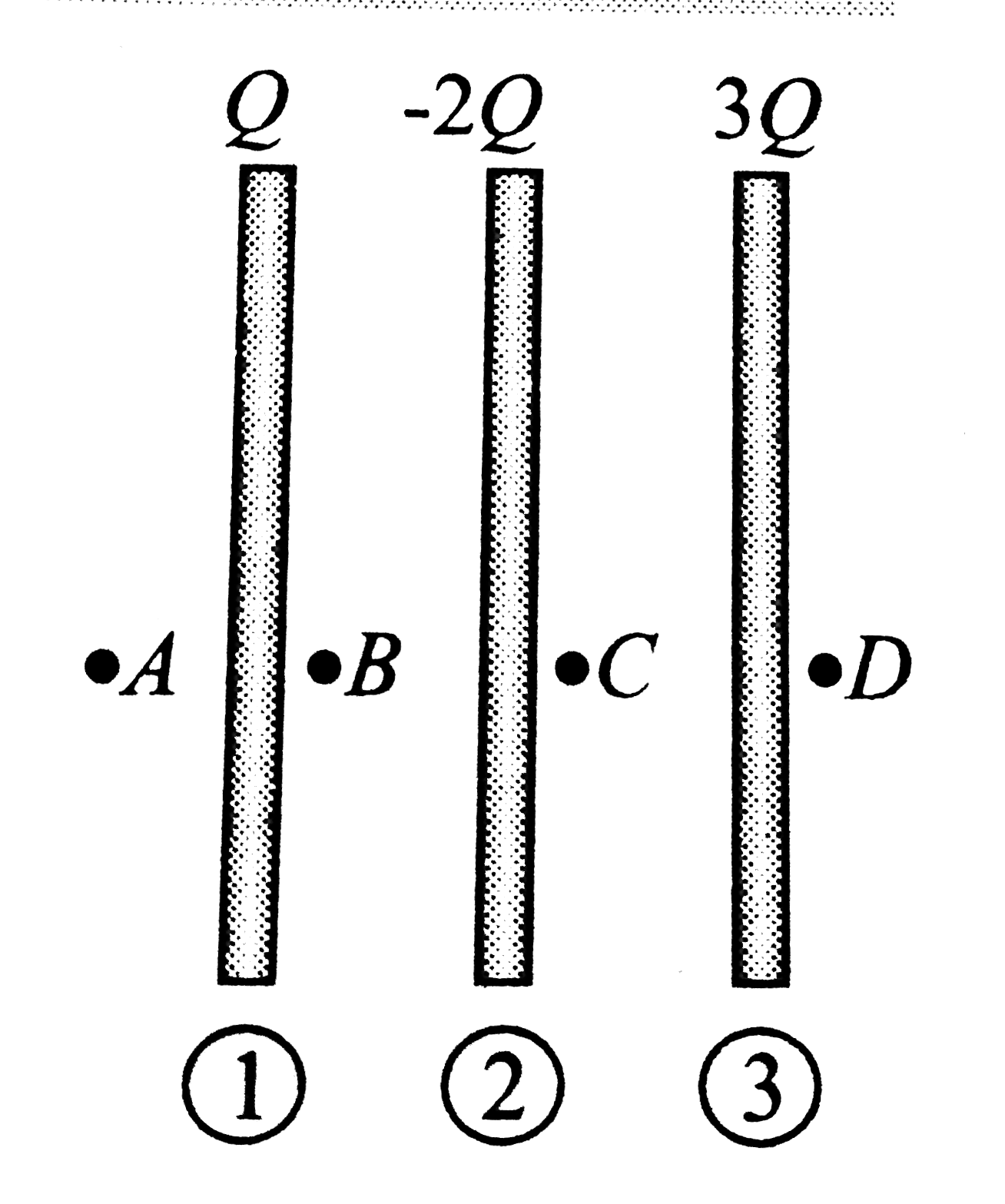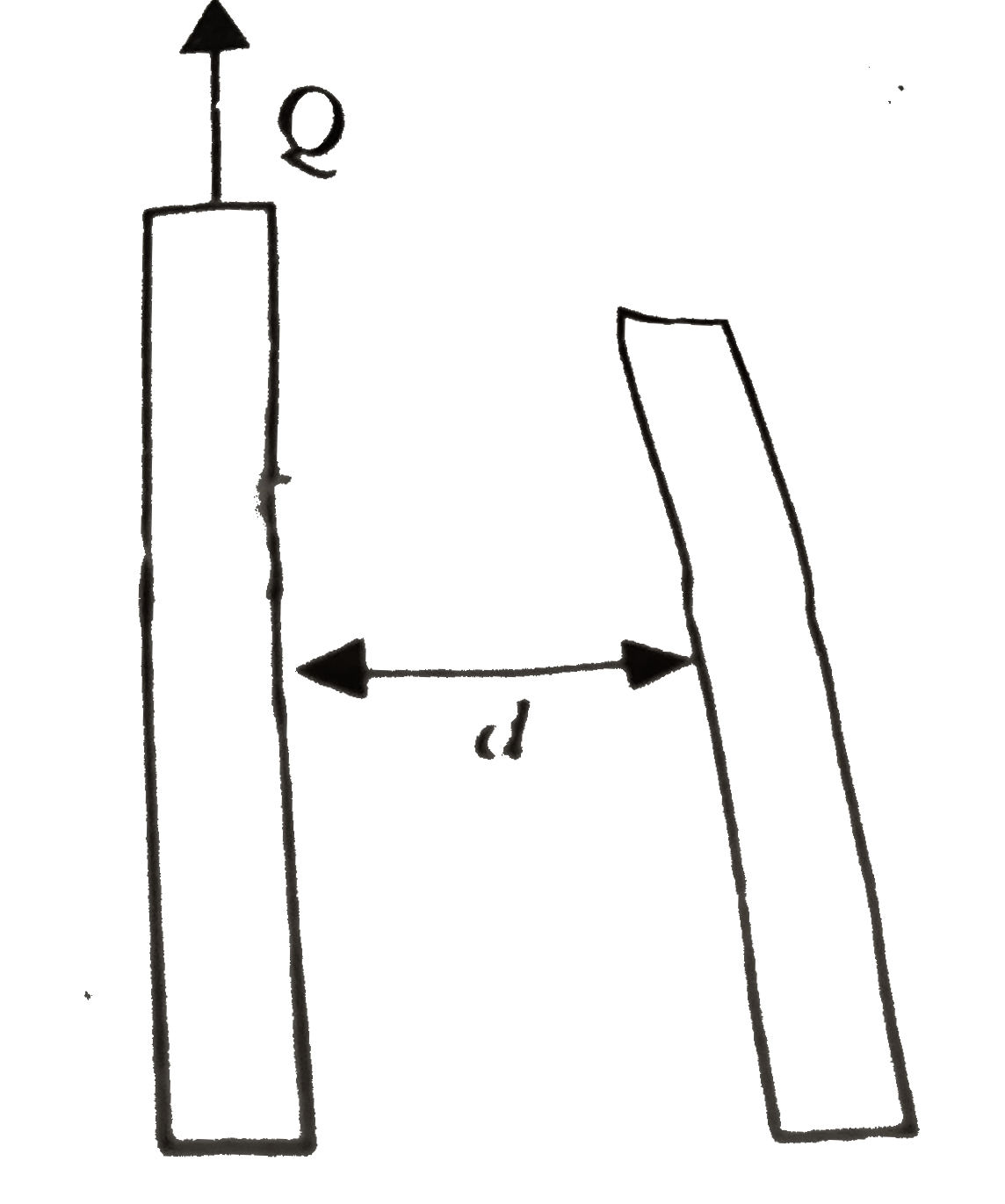Three identical conducting plain parallel plates, each of area A are held with equal distance between successive surfaces. ChargesQ, 2Q, and 3Q are placed on them.Neglecting edge effects, find the distribution of charges on the six surfaces.
The correct Answer is:B, C
To solve the problem of charge distribution on three identical conducting parallel plates with charges Q, 2Q, and 3Q, we will analyze the electrostatic behavior of the system step by step.
1. Understanding the Setup:
- We have three parallel plates (let's call them Plate 1, Plate 2, and Plate 3) with equal area A.
- The charges on these plates are Q on Plate 1, 2Q on Plate 2, and 3Q on Plate 3.
2. Identifying Surfaces:
- Each plate has two surfaces. Thus, we have six surfaces in total:
- Surface 1 (Plate 1, front)
- Surface 2 (Plate 1, back)
- Surface 3 (Plate 2, front)
- Surface 4 (Plate 2, back)
- Surface 5 (Plate 3, front)
- Surface 6 (Plate 3, back)
3. Charge Distribution:
- Since the plates are conductors, charges will redistribute themselves due to electrostatic repulsion until electrostatic equilibrium is reached.
4. Analyzing the Charges:
- Plate 1 has a charge of Q. This charge will distribute itself evenly on its surfaces:
- Surface 1 (front) will have +Q.
- Surface 2 (back) will induce a charge of −Q on Plate 2's front surface due to electrostatic induction.
- Plate 2 has a charge of 2Q. The back surface (Surface 4) will also have a charge of −Q from Plate 1's influence:
- Surface 3 (front) will have +2Q (original charge) + −Q (induced charge) = +Q.
- Surface 4 (back) will have −Q.
- Plate 3 has a charge of 3Q. The back surface (Surface 6) will have a charge of +3Q:
- Surface 5 (front) will have +3Q (original charge) + −Q (induced charge from Plate 2) = +2Q.
5. Final Charge Distribution:
- Surface 1 (Plate 1, front): +Q
- Surface 2 (Plate 1, back): −Q
- Surface 3 (Plate 2, front): +Q
- Surface 4 (Plate 2, back): −Q
- Surface 5 (Plate 3, front): +2Q
- Surface 6 (Plate 3, back): +3Q
Summary of Charge Distribution:
- Surface 1: +Q
- Surface 2: −Q
- Surface 3: +Q
- Surface 4: −Q
- Surface 5: +2Q
- Surface 6: +3Q
- We have three parallel plates (let's call them Plate 1, Plate 2, and Plate 3) with equal area A.
- The charges on these plates are Q on Plate 1, 2Q on Plate 2, and 3Q on Plate 3.
- Each plate has two surfaces. Thus, we have six surfaces in total:
- Surface 1 (Plate 1, front)
- Surface 2 (Plate 1, back)
- Surface 3 (Plate 2, front)
- Surface 4 (Plate 2, back)
- Surface 5 (Plate 3, front)
- Surface 6 (Plate 3, back)
- Since the plates are conductors, charges will redistribute themselves due to electrostatic repulsion until electrostatic equilibrium is reached.
- Plate 1 has a charge of Q. This charge will distribute itself evenly on its surfaces:
- Surface 1 (front) will have +Q.
- Surface 2 (back) will induce a charge of −Q on Plate 2's front surface due to electrostatic induction.
- Surface 3 (front) will have +2Q (original charge) + −Q (induced charge) = +Q.
- Surface 4 (back) will have −Q.
- Surface 5 (front) will have +3Q (original charge) + −Q (induced charge from Plate 2) = +2Q.
- Surface 1 (Plate 1, front): +Q
- Surface 2 (Plate 1, back): −Q
- Surface 3 (Plate 2, front): +Q
- Surface 4 (Plate 2, back): −Q
- Surface 5 (Plate 3, front): +2Q
- Surface 6 (Plate 3, back): +3Q
- Surface 1: +Q
- Surface 2: −Q
- Surface 3: +Q
- Surface 4: −Q
- Surface 5: +2Q
- Surface 6: +3Q
Topper's Solved these Questions
- BOOK - DC PANDEY ENGLISHCHAPTER - ELECTROSTATICSEXERCISE - Exercise 24.14videos
ELECTROSTATICS
- BOOK - DC PANDEY ENGLISHCHAPTER - ELECTROSTATICSEXERCISE - Exercise 24.29videos
ELECTROSTATICS
- BOOK - DC PANDEY ENGLISHCHAPTER - ELECTROSTATICSEXERCISE - Example Type 83videos
ELECTROSTATICS
- BOOK - DC PANDEY ENGLISHCHAPTER - ELECTROSTATIC POTENTIAL AND CAPACITORSEXERCISE - (C) Chapter exercises50videos
ELECTROSTATIC POTENTIAL AND CAPACITORS
- BOOK - DC PANDEY ENGLISHCHAPTER - GRAVITATIONEXERCISE - All Questions135videos
GRAVITATION
Similar Questions
Three parallel metalic plates each of area A are kept as shown in figure and charges q1,q2 and q3 are given to them. Find the resulting charge distribution on the six surfaces, neglecting edge effects as usual,
 View Solution
View SolutionTwo conducting plates A and B are placed parallel to each other. A is given a charge. Q1 and B a charge Q2. Find the distribution of charges on the four surface.
View SolutionTwo parallel metallic pltes , each of tharea A are kept as shown in the figure and charges -2Q and 4Q are given to them. Edge effects are negligeble . The charges on the surface I and III are respectively
 View Solution
View SolutionThree large conducting sheets placed parallel to each other at a finite distance contain charges Q,−2Q,and3Q, respectively. Find the electric fields at points A, B, C, and D.
 View Solution
View SolutionThree identical metallic plates are kept parallel to one another at separations a & b as shown in figure. The outer plates are connected by a thin conducting wire and a charge Q is placed on the central plate. Find the charge on all the six sufaces.
View SolutionThe charge on a parallel plate capacitor varies as q=q0cos2πft. The plates are very large and close together (area=a,separation=d). Neglecting the edge effects, find the displacement current through the capacitor.
View SolutionThe charge on a parallel plate capacitor varies as =q0cos2πft. The plates are very large and close together (area=a,separation=d). Neglecting the edge effects, find the displacement current through the capacitor.
View SolutionTwo parallel conducting plates, each of area A, are separated by a distance d. Now, the left plate is given a positive charge Q. A positive charge q of mass m is released from a point near the left plate. Find the time taken by the charge to reach the right plate.
 View Solution
View SolutionTwo parallel metal plates having charges +Q and −Q face each other at a certain distance between them.If the plates are now dipped in kerosene oil tank ,the electric field between the plates will
View SolutionTwo parallel metal plates having charges +Q and −Q face each other at a certain distance between them.If the plates are now dipped in kerosene oil tank ,the electric field between the plates will
View Solution

